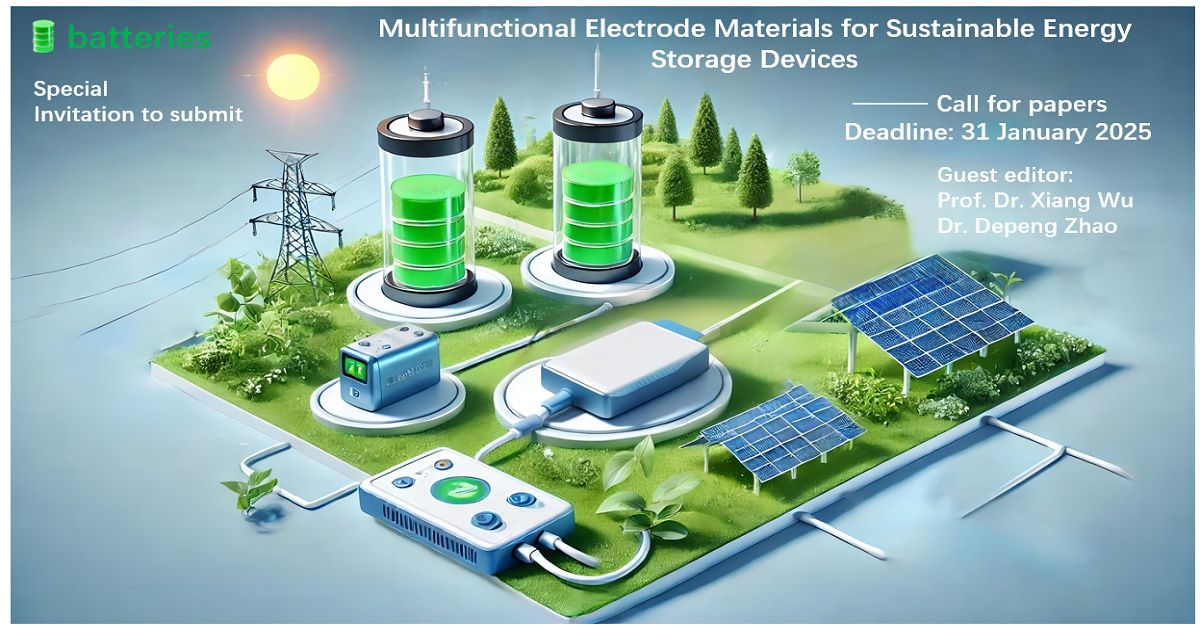- 4.8Impact Factor
- 6.6CiteScore
- 19 daysTime to First Decision
Multifunctional Electrode Materials for Sustainable Energy Storage Devices
This special issue belongs to the section “Battery Materials and Interfaces: Anode, Cathode, Separators and Electrolytes or Others“.
Special Issue Information
Dear Colleagues,
This Special Issue focuses on the cutting-edge research and recent advancements in the field of energy storage systems, specifically targeting various metal-ion batteries, supercapacitors., etc. Metal-ion batteries, known for their high energy density and long cycle life, are widely used in portable electronic devices and electric vehicles. However, challenges such as performance degradation and safety issues remain to be addressed. Supercapacitors, with their high power density and rapid charge–discharge capabilities, show great potential in power system frequency regulation and high-power demand applications. Nevertheless, their relatively low energy density limits broader application. This Special Issue aims to collect the latest research findings in these areas, including material design, performance optimization, mechanism studies, and application prospects. It seeks to explore the current technical challenges and future development directions, providing both theoretical foundations and practical guidance for the advancement of energy storage technologies.
Potential topics include, but are not limited to, the following:
- Electrochemical reactions in rechargeable batteries and supercapacitors;
- Surface/interface chemistry of rechargeable batteries and supercapacitors;
- Electrode materials design for rechargeable batteries and supercapacitors;
- Electrolyte design for rechargeable batteries and supercapacitors;
- Flexible batteries and supercapacitors;
- Batteries and supercapacitors at extreme working temperatures.
Prof. Dr. Xiang Wu
Dr. Depeng Zhao
Guest Editors
Manuscript Submission Information
Manuscripts should be submitted online at www.mdpi.com by registering and logging in to this website. Once you are registered, click here to go to the submission form. Manuscripts can be submitted until the deadline. All submissions that pass pre-check are peer-reviewed. Accepted papers will be published continuously in the journal (as soon as accepted) and will be listed together on the special issue website. Research articles, review articles as well as short communications are invited. For planned papers, a title and short abstract (about 250 words) can be sent to the Editorial Office for assessment.
Submitted manuscripts should not have been published previously, nor be under consideration for publication elsewhere (except conference proceedings papers). All manuscripts are thoroughly refereed through a single-blind peer-review process. A guide for authors and other relevant information for submission of manuscripts is available on the Instructions for Authors page. Batteries is an international peer-reviewed open access monthly journal published by MDPI.
Please visit the Instructions for Authors page before submitting a manuscript. The Article Processing Charge (APC) for publication in this open access journal is 2700 CHF (Swiss Francs). Submitted papers should be well formatted and use good English. Authors may use MDPI's English editing service prior to publication or during author revisions.
Keywords
- Li-S battery
- surface/interface chemistry
- materials design
- hybrid capacitor
- metal ion batteries
- Zn-air battery

Benefits of Publishing in a Special Issue
- Ease of navigation: Grouping papers by topic helps scholars navigate broad scope journals more efficiently.
- Greater discoverability: Special Issues support the reach and impact of scientific research. Articles in Special Issues are more discoverable and cited more frequently.
- Expansion of research network: Special Issues facilitate connections among authors, fostering scientific collaborations.
- External promotion: Articles in Special Issues are often promoted through the journal's social media, increasing their visibility.
- e-Book format: Special Issues with more than 10 articles can be published as dedicated e-books, ensuring wide and rapid dissemination.

